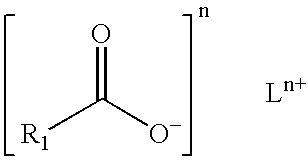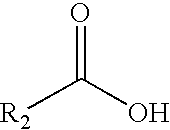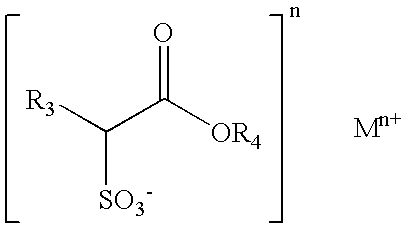Soap bar compositions comprising alpha sulfonated alkyl ester and polyhydric alcohol and process for producing the same
- Summary
- Abstract
- Description
- Claims
- Application Information
AI Technical Summary
Benefits of technology
Problems solved by technology
Method used
Image
Examples
example 1
Procedure for Making Cleaning Bar
[0079] One procedure for making soap / sulfonated methyl ester (SME) bars is as follows:
(1) Neat soap is melted in a steam jacketed crutcher (about 140° F. to about 200° F.)
(2) Free alkalinity of neat soap is neutralized to about 0.1% maximum with inorganic acids, such as phosphoric acid, or organic acid such us coco fatty acids, or citric acid.
(3) Alpha sulfomethyl ester, as a dried paste or an aqueous solution, is added to the crutcher with stirring, and agitation contained for about 5 minutes.
[0080] (4) Additives, such as stearic acid and / or coco fatty acids, mixtures thereof (about 1 to 5%) glycerine (about 0.5% to about 4.0%) and sodium chloride (about 0.1% to about 2.0%) can be introduced into the crutcher at this point and stirring continued for about another 2 to 5 minutes.
(5) The wet soap is air-dried or vacuum-dried to reduce the moisture level to below about 5%.
(6) To milled soap chips, perfume, titanium dioxide and other minor a...
example 2
Disalt Sulfonated Fatty Acid (SFA) Preparation
[0081] Approximately 3500 grams of MC-48 acid is placed in a 4 L beaker and with rapid agitation, approximately 330 grams of sodium hydroxide is added slowly. Upon complete addition of the sodium hydroxide, the resulting SFA material had a thick, pasty consistency. The crude SFA is re-crystallized by washing with methanol, water and salting out the purified SFA product. The crude SFA is analyzed by titrating the material with 0.02N hyamine, which indicated that approximately 46.6% di-sodium salt of MC-48 is present. The recrystallized SFA product is approximately 99.8% di-sodium salt of MC-48.
example 3
1:1 Ratio of SME to SFA Sample Preparation
[0082] Approximately 138.5 grams of MC-48 acid is added to a 1 L resin kettle, equipped with heating means, agitation means, pH measurement means and a nitrogen sweep. The acid is heated to 55° C. and approximately 18.7 g of sodium hydroxide powder is added in small portions. As the sodium hydroxide is added an exotherm of 55° C. to about 71° C. occurred, during which time cooling is provided to keep the mixture below approximately 80° C. Near the end of the sodium hydroxide addition, the mixture became very thick and approximately 15.6 grams of methanol is added to keep the mixture semi-fluid. The final product is a paste at room temperature, i.e. about 25° C. The final SFA / SME product is titrated with 0.02N hyamine which showed the material to be approximately 41.65% SME (mono salt) and approximately 40.34% SFA (di-salt).
PUM
 Login to View More
Login to View More Abstract
Description
Claims
Application Information
 Login to View More
Login to View More - R&D
- Intellectual Property
- Life Sciences
- Materials
- Tech Scout
- Unparalleled Data Quality
- Higher Quality Content
- 60% Fewer Hallucinations
Browse by: Latest US Patents, China's latest patents, Technical Efficacy Thesaurus, Application Domain, Technology Topic, Popular Technical Reports.
© 2025 PatSnap. All rights reserved.Legal|Privacy policy|Modern Slavery Act Transparency Statement|Sitemap|About US| Contact US: help@patsnap.com



